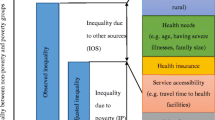Abstract
In spite of good health indicators and an overall good coverage of health services and universal insurance coverage, a number of problems have challenged Swedish health policy in recent years: demographic shift towards an elderly population, increased occurrence of minor mental illness, increased long-term sickness absence. As responsibility for these problems are shared by several sectors in society, increased efforts of collaboration between sectors and authorities have been made. The paper reviews some of these efforts: the reform of the care of the elderly, the mental healthcare reform and various reforms involving health services, social services and social insurance. Some of the reforms have had a major impact in shifting service utilization and increasing awareness within municipalities on groups in need of care and rehabilitation. It is more difficult to find effects on patient outcome. Also, while shared responsibilities may have overall positive effects, some groups risk falling between the stools. Thus, while housing and home care have been improved for large groups, critics have pointed out lack of medical attention and long waiting lists to health services. In addition to financial incentives and organizational changes, major efforts in training, leadership and capacity building are needed to achieve efficient and cost-effective health and social services while maintaining high quality and social equity.
Similar content being viewed by others
References
Alexanderson K, Norlund A (2004). Aim, background, key concepts, regulations, and current statistics. Scandinavian Journal of Public Health 32: 12–30, Chapter 1.
Anderson G, Karlberg I (2000). Integrated care for the elderly. International Journal of Integrated Care 1: 1–12.
Bengtsson-Tops A, Hansson L (1999). Clinical and social needs of schizophrenic out-patients. Relationships of needs and subjective quality of life. Social Psychiatry and Psychiatric Epidemiology 34: 513–518.
Bergman S-E (1998). Swedish models of health care reform: a review and assessment. International Journal of Health Planning and Management 13: 91–106.
Brønnum-Hansen H (2005). Health expectancy in Denmark 1987–2000. European Journal of Public Health 15: 20–25.
Hultberg E-L, Lönnroth K, Allebeck P (2002). Evaluation of the effect of co-financing on collaboration between health care, social services and social insurance in Sweden. International Journal of Integrated Care 2: 1–7.
Hultberg E-L, Lönnroth K, Allebeck P (2005). Interdisciplinary collaboration between primary care, social insurance and social services in the rehabilitation of people with musculoskeletal disorder. Journal of Interprofessional Care 19: 115–124.
Marklund S, Bjurvald M, Hogstedt C, Palmer E, Theorell T (eds) (2005). The High sickness Absence – Problems and Solutions (English Summary). Stockholm: National Institute of Working Life.
Ministry of Social Affairs (1981). Primary care and social services in process of change (Swe: Primärvård och socialtjänst I förändring. Översyn av forskning, utvecklingsarbete, m.m. i Dalby, Tierp och Vilhelmina) DsS: 26.
National Board of Health and Social Welfare (2005). Public Health Report 2005 (Swe: Folkhälsorapport).
National Board of Social Insurance and National Board of Health and Welfare (1997). FINSAM – final report (Swe: FINSAM – slutrapport).Finansiell samordning: 1.
National Board of Social Insurance and National Board of Health and Welfare (2001). SOCSAM – final report (Swe: SOCSAM – forsök med politisk och finansiell samordning. En slutrapport. Finansiell samordning): 1.
Östman M, Hansson L (2000). Family burden, participation in care and mental health. An 11-year comparison of relatives to compulsory and voluntalriy admitte patients. International Jounral of Social Psychiatry 46: 191–200.
Palme J, Bermark Å, Bäckman O et al. (2003). A welfare balance sheet for the 1990s. Scandinavian Journal of Public Health Supplement 60: 57–59.
Persson G, Barlow L, Karlsson A et al. (2001). Major health problems. Scandinavian Journal of Public Health 29: 37–102, Chapter 3.
Rosén M, Haglund B (2005). From healthy survivors to sick survivors – implications for the twenty-first century. Scandinavian Journal of Public Health 33: 151–155.
Stefansson C-G, Hansson L (2001). Mental health care reform in Sweden, 1995. Acta Psychiatrica Scandinavica 104: 82–88.
Author information
Authors and Affiliations
Rights and permissions
About this article
Cite this article
Allebeck, P. Mapping Household-Based Health Security – The Case of Sweden. Soc Theory Health 6, 60–73 (2008). https://doi.org/10.1057/palgrave.sth.8700107
Published:
Issue Date:
DOI: https://doi.org/10.1057/palgrave.sth.8700107



